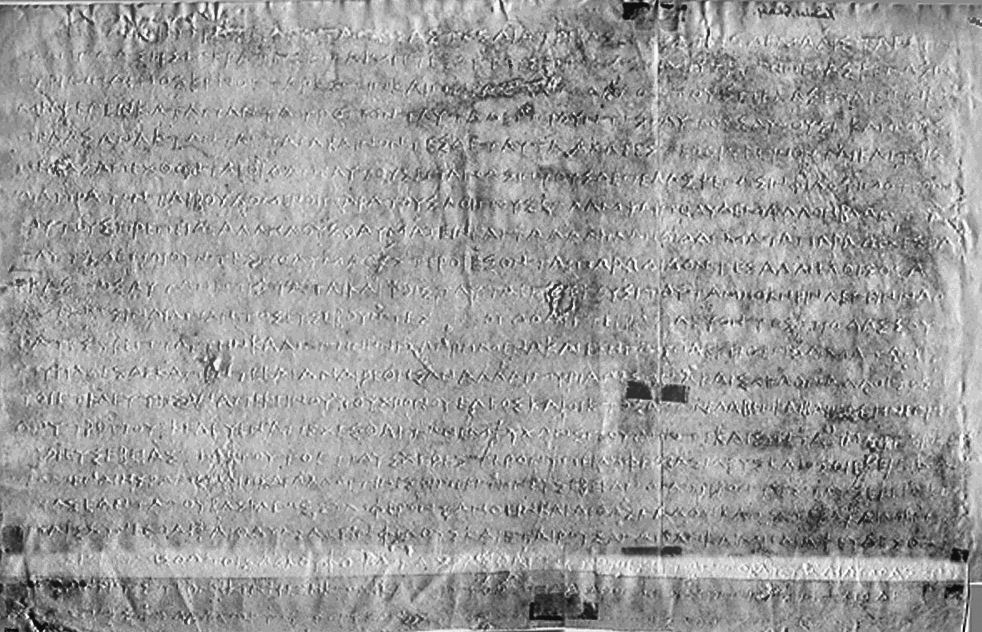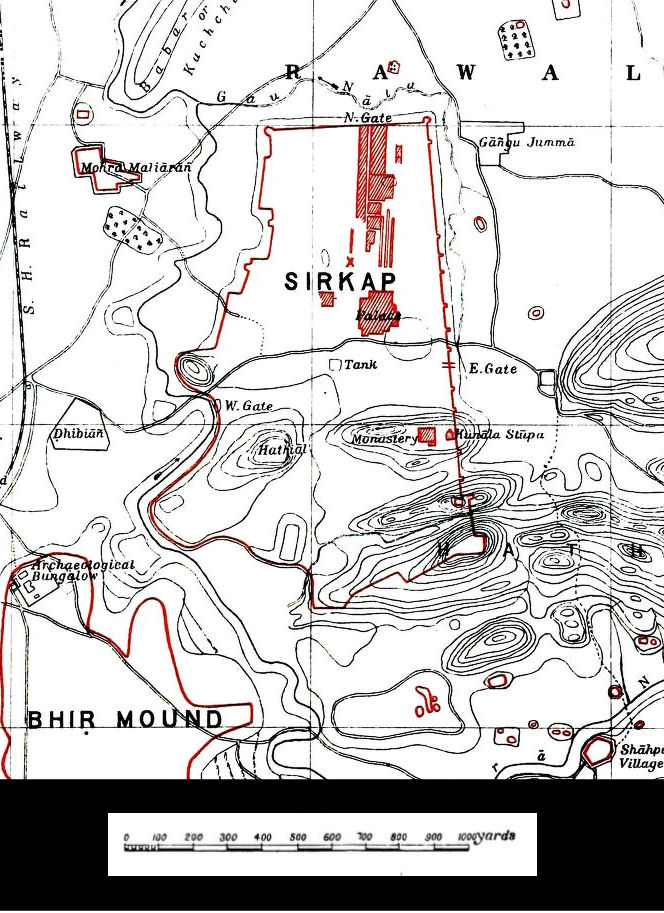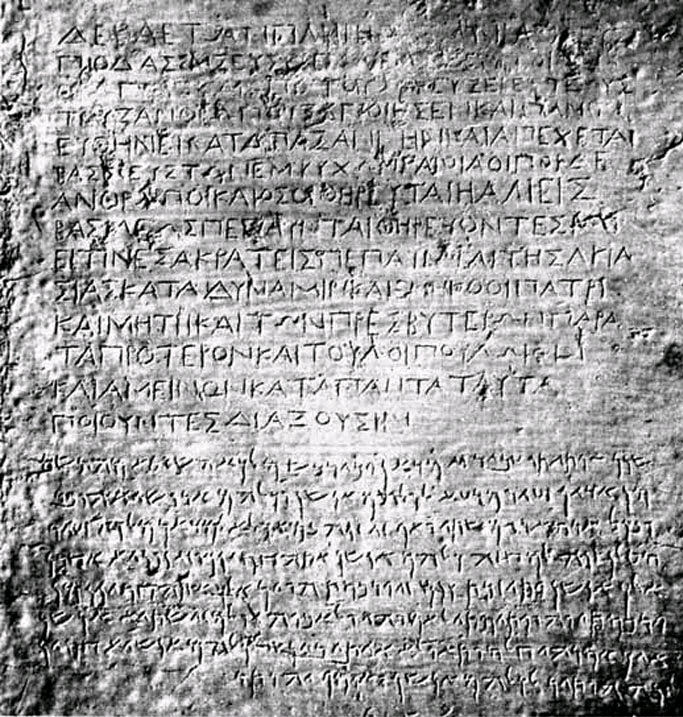|
Aramaic Inscription Of Taxila
The Aramaic Inscription of Taxila is an inscription on a piece of marble, originally belonging to an octagonal column, discovered by Sir John Marshall in 1915 at Taxila, British India. The inscription is written in Aramaic, probably by the Indian emperor Ashoka around 260 BCE, and often categorized as one of the Minor Rock Edicts.Asoka by Radhakumud Mookerjp.275/ref> Since Aramaic was the official language of the Achaemenid empire, which disappeared in 330 BCE with the conquests of Alexander the Great, it seems that this inscription was addressed directly to the populations of this ancient empire still present in northwestern India, or to border populations for which Aramaic remained the normal communication language.A new Aramaic inscription of Asoka found in the Laghman Valley (Afghanistan), André Dupont-Sommer Proceedings of the Academy of Inscriptions and Belles-Lettres Year 1970 114-p.173/ref> The inscription is known as KAI 273. Related inscriptions The discovery of this in ... [...More Info...] [...Related Items...] OR: [Wikipedia] [Google] [Baidu] |
Aramaic Language
The Aramaic languages, short Aramaic ( syc, ܐܪܡܝܐ, Arāmāyā; oar, 𐤀𐤓𐤌𐤉𐤀; arc, 𐡀𐡓𐡌𐡉𐡀; tmr, אֲרָמִית), are a language family containing many varieties (languages and dialects) that originated in the ancient region of Syria. For over three thousand years, It is a sub-group of the Semitic languages. Aramaic varieties served as a language of public life and administration of ancient kingdoms and empires and also as a language of divine worship and religious study. Several modern varieties, namely the Neo-Aramaic languages, are still spoken in the present-day. The Aramaic languages belong to the Northwest group of the Semitic language family, which also includes the Canaanite languages such as Hebrew, Edomite, Moabite, and Phoenician, as well as Amorite and Ugaritic. Aramaic languages are written in the Aramaic alphabet, a descendant of the Phoenician alphabet, and the most prominent alphabet variant is the Syriac alphab ... [...More Info...] [...Related Items...] OR: [Wikipedia] [Google] [Baidu] |
Kandahar Greek Edict Of Ashoka
The Kandahar Greek Edicts of Ashoka are among the Major Rock Edicts of the Indian Emperor Ashoka (reigned 269-233 BCE), which were written in the Greek language and Prakrit language. They were found in the ancient area of Old Kandahar (known as Zor Shar in Pashto, or Shahr-i-Kona in Farsi) in Kandahar in 1963. It is thought that Old Kandahar was founded in the 4th century BCE by Alexander the Great, who gave it the Ancient Greek name Ἀλεξάνδρεια Ἀραχωσίας (Alexandria of Arachosia). The extant edicts are found in a plaque of limestone, which probably had belonged to a building, and its size is 45x69.5 cm and it is about 12 cm thick. These are the only Ashoka inscriptions thought to have belonged to a stone building.Une nouvelle inscription grecque d'Açoka, Schlumberger, Daniel, Comptes rendus des séances de l'Académie des Inscriptions et Belles-Lettres Année 1964 Volume 108 Numéro 1 pp. 126-14/ref> The beginning and the end of the fra ... [...More Info...] [...Related Items...] OR: [Wikipedia] [Google] [Baidu] |
Edicts Of Ashoka
The Edicts of Ashoka are a collection of more than thirty inscriptions on the Pillars of Ashoka, as well as boulders and cave walls, attributed to Emperor Ashoka of the Maurya Empire who reigned from 268 BCE to 232 BCE. Ashoka used the expression ''Dhaṃma Lipi (script), Lipi'' (Prakrit in the Brahmi script: wikt:𑀥𑀁𑀫𑀮𑀺𑀧𑀺, 𑀥𑀁𑀫𑀮𑀺𑀧𑀺, "Inscriptions of the Dharma") to describe his own Edicts. These inscriptions were dispersed throughout the areas of modern-day Bangladesh, India, Nepal, Afghanistan and Pakistan, and provide the first tangible evidence of Buddhism. The edicts describe in detail Ashoka's policy of Dhamma, Ashoka's view on dhamma, an earnest attempt to solve some of the problems that a complex society faced. According to the edicts, the extent of Buddhist proselytism during this period reached as far as the Mediterranean Sea, Mediterranean, and many Buddhist monuments were created. These inscriptions proclaim Ashoka's adherenc ... [...More Info...] [...Related Items...] OR: [Wikipedia] [Google] [Baidu] |
Archaeology In Pakistan
Pakistan contains many of the oldest archaeological discoveries of the world. The country is home to many archaeological sites dating from Lower Paleolithic period to Mughal empire. The earliest known archaeological findings belong to the Soanian culture from the Soan Valley, near modern-day Islamabad. Soan Valley culture is considered as the best known Palaeolithic culture of Central Asia. The Mehrgarh culture was amongst the first cultures in the world to establish agriculture and livestock and live in villages. Mehrgarh civilization lasted for 5000 years till 2000 BCE after which people migrated to other areas, possibly Harappa and Mohenjo-daro. Harappa and Mohenjo-daro are the best known sites from the Indus Valley civilization The Indus Valley Civilisation (IVC), also known as the Indus Civilisation was a Bronze Age civilisation in the northwestern regions of South Asia, lasting from 3300 BCE to 1300 BCE, and in its mature form 2600 BCE to 1900 .. ... [...More Info...] [...Related Items...] OR: [Wikipedia] [Google] [Baidu] |
3rd-century BC Works
The 3rd century was the period from 201 ( CCI) to 300 ( CCC) Anno Domini (AD) or Common Era (CE) in the Julian calendar.. In this century, the Roman Empire saw a crisis, starting with the assassination of the Roman Emperor Severus Alexander in 235, plunging the empire into a period of economic troubles, barbarian incursions, political upheavals, civil wars, and the split of the Roman Empire through the Gallic Empire in the west and the Palmyrene Empire in the east, which all together threatened to destroy the Roman Empire in its entirety, but the reconquests of the seceded territories by Emperor Aurelian and the stabilization period under Emperor Diocletian due to the administrative strengthening of the empire caused an end to the crisis by 284. This crisis would also mark the beginning of Late Antiquity. In Persia, the Parthian Empire was succeeded by the Sassanid Empire in 224 after Ardashir I defeated and killed Artabanus V during the Battle of Hormozdgan. The Sassanids t ... [...More Info...] [...Related Items...] OR: [Wikipedia] [Google] [Baidu] |
List Of Edicts Of Ashoka
The following is an overview of Edicts of Ashoka, and where they are located. Minor Rock Edict *Kandahar, Afghanistan *Lampaka, Afghanistan * Bahapur, Delhi * Bairat, near Jaipur, Rajasthan *Bhabru, second hill at Bairat, Rajasthan *Gujarra, near Jhansi, Datia district, Madhya Pradesh *Rupnath, on the Kaimur Hills near Jabalpur, Madhya Pradesh *Ratanpurwa, on the Kaimur Hills near Kharauli-Basaha Road, Bihar *Panguraria, Sehore district, Madhya Pradesh *Sohgaura, Gorakhpur district, Uttar Pradesh *Sahasram, Rohtas district, Bihar *Barabar Caves, Bihar (donatory inscriptions to the Ājīvika sect) * Mahasthan, Bogra district, Bangladesh *Rajula-Mandagiri, near Pattikonda, Kurnool district, Andhra Pradesh *Suvarnagiri (Jonnagiri), Kurnool district, Andhra Pradesh * Palkigundu and Gavimath, Koppal district, Karnataka * Brahmagiri, Chitradurga district, Karnataka *Jatinga-Rameshwara, near Brahmagiri, Karnataka *Siddapur, near Brahmagiri, Karnataka *Maski, Raichur district, Karnata ... [...More Info...] [...Related Items...] OR: [Wikipedia] [Google] [Baidu] |
Sirkap Aramaic Inscription 4th Century BC (text)
Sirkap (Urdu and pnb, ) is the name of an archaeological site on the bank opposite to the city of Taxila, Punjab, Pakistan. The city of Sirkap was built by the Greco-Bactrian king Demetrius after he invaded modern-day Pakistan around 180 BC. Demetrius founded an Indo-Greek kingdom that was to last until around 10 BC. Sirkap is also said to have been rebuilt by king Menander I. Archaeological excavations The excavation of the old city was carried out under the supervision of Sir John Marshall by Hergrew from 1912–1930. In 1944 and 1945 further parts were excavated by Mortimer Wheeler and his colleagues. Most of the discoveries at Sirkap related to the Indo-Scythian and Indo-Parthian periods (1st-2nd century CE). Overall excavations to the Greek levels have been very limited, and probably much remains hidden underground: in Sirkap, only about one eight of the excavations were made down to the Indo-Greek and early Indo-Scythian levels, and this only in an area far removed f ... [...More Info...] [...Related Items...] OR: [Wikipedia] [Google] [Baidu] |
Imperial Aramaic
Imperial Aramaic is a linguistic term, coined by modern scholars in order to designate a specific historical variety of Aramaic language. The term is polysemic, with two distinctive meanings, wider (sociolinguistic) and narrower ( dialectological). Some scholars use the term as a designation for a distinctive, socially prominent phase in the history of Aramaic language, that lasted from the middle of the 8th century BCE to the end of the 4th century BCE and was marked by the use of Aramaic as a language of public life and administration in the late Neo-Assyrian Empire and its successor states, the Neo-Babylonian Empire and the Achaemenid Empire, also adding to that some later (Post-Imperial) uses that persisted throughout the early Hellenistic period. Other scholars use the term ''Imperial Aramaic'' in a narrower sense, reduced only to the Achaemenid period, basing that reduction on several strictly linguistic distinctions between the previous (Neo-Assyrian and Neo-Babylonian) p ... [...More Info...] [...Related Items...] OR: [Wikipedia] [Google] [Baidu] |
Dineshchandra Sircar
Dineshchandra Sircar (1907–1985), also known as D. C. Sircar or D. C. Sarkar, was an epigraphist, historian, numismatist and folklorist, known particularly in India and Bangladesh for his work deciphering inscriptions. He was the Chief Epigraphist of the Archaeological Survey of India (1949–1962), Carmichael Professor of Ancient Indian History and Culture at the University of Calcutta (1962–1972) and the General President of the Indian History Congress. In 1972, Sircar was awarded the Sir William Jones Memorial Plaque. Early life and education Sircar was born to a family of Ayurvedic physicians at Krishnanagar. He graduated with Honours in Sanskrit in 1929 and obtained a First Class in his MA Examination in 1931 in Ancient Indian History and Culture with specialisation in Epigraphy and Numismatics from the University of Calcutta. Selected bibliography He authors more than forty books both in Bengali and English. Some of his best-known books include: * ''পা� ... [...More Info...] [...Related Items...] OR: [Wikipedia] [Google] [Baidu] |
Priyadasi
Priyadasi, also Piyadasi or Priyadarshi (Brahmi: 𑀧𑀺𑀬𑀤𑀲𑀺 ''piyadasi'', Kharosthi: 𐡐𐡓𐡉𐡃𐡓𐡔 ''Prydrš''), was the name of a ruler in ancient India, or simply an honorific epithet which means "He who regards others with kindness", "Humane", "He would glances amiably". The title "Priyadasi" appears repeatedly in the ancient inscriptions known as the Major Rock Edicts or the Major Pillar Edicts, where it is generally used in conjunction with the title ''"Devanampriya"'' ("Beloved of the Gods") in the formula "Devanampriya Priyadasi". Some of the inscriptions rather use the title "Rajan Priyadasi" ("King Priyadarsi"). It also appears in Greek in the Kandahar Bilingual Rock Inscription (c. 260 BCE), when naming the author of the proclamation as βασι ��ὺς Πιοδασσης (" Basileus Piodassēs"), and in Aramaic in the same inscription as "our lord, king Priyadasin" ( Kharosthi: 𐡐𐡓𐡉𐡃𐡓𐡔, Modern Hebrew: ''pryd’rš''). Acco ... [...More Info...] [...Related Items...] OR: [Wikipedia] [Google] [Baidu] |
Aramaic Inscription Of Laghman
The Aramaic inscription of Laghman, also called the Laghman I inscription to differentiate from the Laghman II inscription discovered later, is an inscription on a slab of natural rock in the area of Laghmân, Afghanistan, written in Aramaic by the Indian emperor Ashoka about 260 BCE, and often categorized as one of the Minor Rock Edicts of Ashoka. This inscription was published in 1970 by André Dupont-Sommer. Since Aramaic was an official language of the Achaemenid Empire, and reverted to being just its vernacular tongue in 320 BCE with the conquests of Alexander the Great, it seems that this inscription was addressed directly to the populations of this ancient empire still present in this area, or to border populations for whom Aramaic remained the language used in everyday life.A new Aramaic inscription of Asoka found in the Laghman Valley (Afghanistan), André Dupont-Sommer Proceedings of the Academy of Inscriptions and Belles-Lettres Year 1970 114-pp.158-173/ref> Epigrap ... [...More Info...] [...Related Items...] OR: [Wikipedia] [Google] [Baidu] |
Kandahar
Kandahar (; Kandahār, , Qandahār) is a city in Afghanistan, located in the south of the country on the Arghandab River, at an elevation of . It is Afghanistan's second largest city after Kabul, with a population of about 614,118. It is the capital of Kandahar Province as well as the de facto capital of the Taliban, formally known as the Islamic Emirate of Afghanistan. It also happens to be the centre of the larger cultural region called Loy Kandahar. In 1709, Mirwais Hotak made the region an independent kingdom and turned Kandahar into the capital of the Hotak dynasty. In 1747, Ahmad Shah Durrani, founder of the Durrani dynasty, made Kandahar the capital of the Afghan Empire. Historically this province is considered as important political area for Afghanistan revelations. Kandahar is one of the most culturally significant cities of the Pashtuns and has been their traditional seat of power for more than 300 years. It is a major trading center for sheep, wool, cotton, silk, fel ... [...More Info...] [...Related Items...] OR: [Wikipedia] [Google] [Baidu] |







